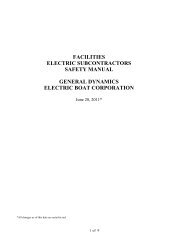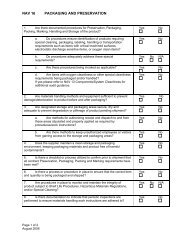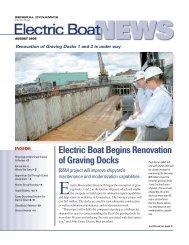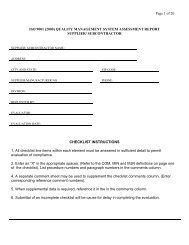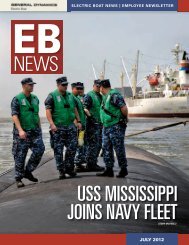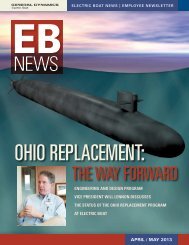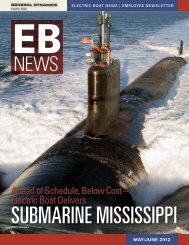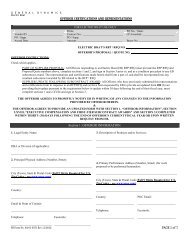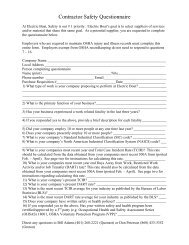EB News January 2010 - Electric Boat Corporation
EB News January 2010 - Electric Boat Corporation
EB News January 2010 - Electric Boat Corporation
- No tags were found...
You also want an ePaper? Increase the reach of your titles
YUMPU automatically turns print PDFs into web optimized ePapers that Google loves.
JANUARY <strong>2010</strong>INSIDE<strong>EB</strong>AC Names Award Winners • 2<strong>Electric</strong> <strong>Boat</strong> EmployeesRaise More Than $58,000For Heart Association • 3General Dynamics ReportsStrong Results For Fourth Quarter,Full-Year 2009 • 4Marine <strong>News</strong> Roundup • 5Daffodil Days Are Coming • 6Alvarez Is RecognizedFor Contribution To EngineeringWith Two Awards • 7Health Matters • 8/9Retirees / Ethics • 10Service Awards • 11Safety Performance • 12ELECTRIC BOAT EMPLOYEES ARE RECOGNIZEDFOR MILITARY SERVICEEight <strong>Electric</strong> <strong>Boat</strong> employees who returned from militarydeployments last year were honored for their service recentlyat a recognition ceremony held in the Technology Center.“We want to thank you and recognize you for what you’ve done forour country,” said <strong>Electric</strong> <strong>Boat</strong> President John Casey. “We’re fortunateto have you as employees and co-workers and we appreciate whatyou’ve done on behalf of our country,” he said, offering them whateverassistance they might need in transitioning back to civilian life.The employees recognized were:continued on page 6<strong>Electric</strong> <strong>Boat</strong> employees whoreturned from military deploymentsin 2009 were honoredrecently by President JohnCasey and his staff. From left areJonathan Seavey II (951),Michael Lopes (449), Erin Foster(951), Michael Baycura (449),George Butz (456) and MichaelRushton (447). Missing from thephoto are Michael Jarrie (967)and Patrick Meehan (931).
<strong>EB</strong>AC Names Award WinnersO.P. Robinson Jr. Memorial Awardand Walter J. Harvey Memorial Award WinnerMike CoughlinMike Coughlin is the recipient of both the O.P. Robinson Award for theOutstanding Varsity Athlete of the Year and the Walter J. Harvey Award for theOutstanding Interdepartmental Athlete of the Year.Joining the Men’s Varsity Hockey Team in 2008, Coughlin scored 35 goals andhad 11 assists, helping the team win the 2008 league championship as well as theplayoff championship. He also plays on the Men’s Varsity Softball Team as anoutfielder and contributed to the team’s third-place regular season and playofffinish (out of 18 teams).In the <strong>EB</strong>AC Interdepartmental Softball League, Coughlin helped his team,Par Four, achieve a 16-4 record and a first-place regular season finish. During theseason, he led the B Division in home runs (14), RBIs (56), doubles (11) and runs(35), and finished with a .648 batting average.Playing for Dano’s Red Storm in the Interpartmental Floor Hockey League,Coughlin led the league in scoring with 20 goals and seven assists and contributedto the team’s second-place finish. He was named Rookie of the Year for the 2008season.Mike CoughlinDorothy Bliven Award WinnerMegan RobertsMegan Robert was selected to receive the Dorothy Bliven Award, given to the<strong>EB</strong>AC’s Outstanding Woman Athlete for her accomplishments on the Running andGolf teams.Since joining the Golf Team in 2004, Roberts has improved her handicap by ninestrokes. In 2008, she tied for first place in the B Division, winning 85 percent of hermatches and taking second place in the playoff. She also received the HelenDeWolfe award for league contributions, congeniality and sportsmanship.As a member of the Varsity Running Team, Roberts was named Most ValuableRunner in 2007, and completed the Boston Marathon in 2008. She also competedin the Special Olympics 5K, taking second place and helping the <strong>EB</strong>AC team to asecond-place finish in the corporate division. In the <strong>EB</strong>AC Fall Challenge, sheplaced third, helping the team finish second in the corporate division.Megan Roberts<strong>EB</strong>AC President’s AwardsThis award is presented to individuals in recognition of the extraordinary support they have provided the <strong>EB</strong>AC.Michelle Lea was recognized for her support of the <strong>EB</strong>AC Ski Club, Running Club and Varsity Running Team.John Klinefelter was honored for volunteering when the <strong>EB</strong>AC needed a new retiree golf commissioner.Dwight Snowberger was selected for stepping in to fill the vacant <strong>EB</strong>AC webmaster position.2 I <strong>January</strong> <strong>2010</strong> I ELECTRIC BOAT NEWS
M A R I N E N E W S R O U N D U PAMSEA Awarded$27 Million ContractBy Military SealiftCommandQUINCY, Mass.American Overseas Marine (AMSEA)has been awarded a $27.2 million operationsand maintenance services contractby the U.S. Navy’s Military Sealift Command(MSC).Through this contract, AMSEA, apart of GD’s Marine Systems group, willprovide full-service operations and maintenancefor seven Navy Large, Medium-Speed, Roll-On/Roll-Off (LMSR) vessels.Services will include crewing, engineering,maintenance, procurement and provisioning.“AMSEA has successfully operatedthe vessels in this program for the lastfive years and looks forward to continuingour superior service for our customerunder this new contract,” said Capt.Thomas Merrell, AMSEA president.MSC's LMSR program significantlyenhances the U.S. sealift capability forthe new millennium. LMSRs have beenthe primary movers of U.S. militaryequipment during Operation EnduringFreedom and Operation Iraqi Freedom.Each LMSR can carry an entire U.S.Army Task Force, including 58 tanksand 48 other tracked vehicles, as well asmore than 900 trucks and other wheeledvehicles. The LMSRs are each crewed byabout 30 civilian mariners.As a full service ship operator formore than 25 years, AMSEA providescomplete marine operations, engineeringand professional services to customers inthe government and commercial sectors.continued on page 6Submarine New Mexico Delivered to Navy<strong>Electric</strong> <strong>Boat</strong>’s Virginia-program construction partner, Northrop Grumman Shipbuilding, last month deliveredthe sixth ship of the class, New Mexico (SSN-779), to the U.S. Navy. NGS photoELECTRIC BOAT NEWS I <strong>January</strong> <strong>2010</strong> I 5
Alvarez Is Recognized For ContributionTo Engineering With Two AwardsAustin AlvarezAlvarez has more than40 years of experience at<strong>Electric</strong> <strong>Boat</strong> in structuralengineering, underwaterexplosion, and shock andvibration analysis, includingmore than 28 yearsmanaging programs andengineers on numerouscomplex tasks.<strong>Electric</strong> <strong>Boat</strong> Staff EngineerAustin Alvarez (463) hasreceived two major awards inrecognition of his contributions to theengineering profession and the nuclearsubmarineindustry over the course of hiscareer at the company.The Shock and Vibration InformationAnalysis Center (SAVIAC) namedAlvarez as the recipient of its 2009 LifetimeAchievement Award for his technicalskills, leadership and pioneering work inshock designs and analytical methodsused in the development of Los Angeles,Ohio, Seawolf and Virginia-class submarines,as well as contributions to theshock and vibration field itself. He is oneof SAVIAC’s 15 Lifetime AchievementAward winners.Alvarez received his second award fromthe University of Connecticut’s School ofEngineering, which selected him forinduction into its Academy of DistinguishedEngineers. As an academy member,Alvarez will provide advice and counselto the dean, department heads, centerdirectors, faculty and students of the engineeringschool.Two other <strong>Electric</strong> <strong>Boat</strong> alumni –retired GD Executive Vice President MikeToner and retired Engineering DirectorRay Williams – were previously inductedinto the academy.Alvarez has more than 40 years ofexperience at <strong>Electric</strong> <strong>Boat</strong> in structuralengineering, underwater explosion, andshock and vibration analysis, includingmore than 28 years managing programsand engineers on numerous complextasks.The shock design and analysis capabilitiesdeveloped under Alvarez’s directionmade transient underwater shock analysisa reality for submarine design and analysis.This work also significantly acceleratedthe acceptance of transient shockanalysis technologies for naval submarineshock qualification and the methods arestill used for shock qualification efforts ofstructural and mechanical items.Alvarez also directed assessments of apayload interface module and payloadmodular structures that would significantlyincrease submarine payloads. Theoptions evaluated included internal andexternal payload bay concepts, similar tothose of the Space Shuttle, and variouspayload tube concepts. This work ultimatelyled to the Virginia-class bowredesign, which Alvarez supports as theshock and structures project manager.He also is the shock and structures projectmanager for the Ohio ReplacementProgram.Between 2004 and 2009, Alvarez wasthe design review team leader of theGraving Dock Assessment Team. Thismulti-organizational team conceived anddesigned an innovative reinforced concretewall that provided a 75-year life extensionfor Graving Dock 3 and a unique reinforcedconcrete encapsulation scheme thatwill extend the lives of Graving Docks 1and 2 for 50 years.For this graving dock life extensionwork and his accomplishments over theyears, Alvarez received the GeneralDynamics Technology Excellence Awardfor <strong>Electric</strong> <strong>Boat</strong>.In addition to his <strong>Electric</strong> <strong>Boat</strong> career,Alvarez has also been involved withSAVIAC and the Shock and VibrationSymposium for nearly 30 years. He hasbeen a member of the Technical AdvisoryGroup for nearly 20 years, served as theco-chair of the Program Committee ofthree symposia and has served on numerousSAVIAC committees.ELECTRIC BOAT NEWS I <strong>January</strong> <strong>2010</strong> I 7
One of the reasons we break our promises to ourselves and others isthat it’s difficult to change ingrained behaviors. When broken down tothe smallest of acts, behaviors are really habits, based on preferences.HEALTHMATTERSBob Hurley, MDMedical DirectorNewYear’sResolutionsI’ve been thinking about my NewYear’s resolutions and I’ve concludedthat I’m going to need alittle help this year. It didn’t help toread that a recent British study foundthat 88 percent of individuals fail withtheir New Year’s resolutions and fewerthan half manage to keep them for aslong as one month. Like most, I readthese statistics and assume that thelack of willpower is largely a characterissue. Those 88 percent may have succeededif only they had a little bitmore discipline and follow through. Ifyou agree with me in this notion, well… we’re both wrong.One of the reasons we break ourpromises to ourselves and others isthat it’s difficult to change ingrainedbehaviors. When broken down to thesmallest of acts, behaviors are reallyhabits, based on preferences. So inshort, New Year’s resolutions are reallya longing for behaviors that we are nototherwise likely to do. If resolutionswere truly based on preferences then itwould make more sense for a couchpotato to resolve to watch more television.Since we elect to change behaviorsthat are often difficult to change,we need to accept the fact that failureis a distinct possibility.Willpower and Flehman ResponsesOur failure to succeed in New Year’sresolutions or healthy habits has to dowith a deficient prefrontal cortex andloss of Flehman responses. True, wehave remnants of Flehman responsessuch as anger and aggression. But trueFlehman responses are the instinctualbehavior of many animal species. Theseresponses are “fixed-action patterns,”meaning they are genetically tied andinherited as opposed to learned or reasoned.These fixed-action patterns areperformed by all animals within aspecies even if they are raised apart orin isolation. The patterns are soingrained that once they are triggered,they are performed in an exactsequence to completion. What does ittake to trigger these responses? Theshort answer is environmental cues.These environmental cues act as“releasers” to the subsequent behaviors.Animals typically exhibit only healthyFlehman responses as natural selectionhas decided which are advantageous tothe species.I wish someone would figure out myFlehman response for diet and exercise.Imagine being in your home, you lookin the mirror and you automatically godownstairs and put an hour on theelliptical and 45 minutes on the weights.How about reading a food label, whichin turn triggers a distaste for fatty foodsand a preference for a salad, day afterday, with no sense of deprivation,remorse or conscious thought.Environmental CuesThe trade-off for higher-level consciousnessis the loss of healthy instinctualbehaviors. We do, however, stillrespond to environmental cues andtiming. For example, people who havea stable life are more likely to havefixed habits or schedules. For themadhering to their routines is simple. Itdoesn’t require much mental energy orconscious thought. They learn theirhealthy habits in this context. Whenthese same people change the contextin which they're performing theirhabits, the rate of failure rises significantly.For example, think about howactive you are in the summertime. Haveyou been able to transfer that samelevel of activity when winter arrived?Many of us cease to perform behaviorswhen the environment changes.Get a HabitSo what can we do to optimize successwith our New Year’s resolutions?It is not enough to think about yourresolutions for a few days before NewYear's Eve and then hope that you willbe strong enough to carry through onthem.It’s a fact that people who maintainrituals in their everyday life struggle farless in their conscious thinking thanthose who have to decide when and8 I <strong>January</strong> <strong>2010</strong> I ELECTRIC BOAT NEWS
where to perform their target behavior.There are three principles to be mindfulof:1. Habits are contingent on environmentalcues, i.e., same place/same time.2. Habits develop when people arepassionate about pursuing a particulargoal, and the habits will persist evenwhen a person has reached their target.For example, exercising is likely tocontinue even after the target weighthas been attained if the contextremains constant.3. Habits do not change to meet currentgoals; they remain linked to theenvironment in which they were created,e.g., flossing in your bathroom athome may not transfer to your hotelroom when you're on vacation.So, if maintaining an environmentalcontext perpetuates behaviors, whathappens when we purposefully alterour environment? First, accept the factthat changing your environmentrequires some time and effort toaccomplish. Second, you’ll need tolook and be aware of what cues in yourenvironment triggers unhealthy behaviors.I doubt you’ll exhibit fixed-actionpatterns but making small changes willinfluence your behaviors. Try placingyour couch in a position that makesviewing the TV less enjoyable. It’llresult in less TV viewing. Don’t buy icecream. If it’s not in your freezer, you’lleat less of it. You can also change yourpatterns by disrupting your habits. Forexample, changing the location of yourpots and pans will force you to thinkthe next time you prepare a meal. Thethought process in turn spurs innovationin diet and new recipes.Cake andTelephone NumbersGiven the above I’d suggest you outsourceas many of your healthylifestyle behaviors as possible to yourunconscious mind. Why? Because theconscious area of the brain recognizedas the center for willpower is underdeveloped.The culprit is the prefrontalcortex, which is located just behind theforehead. And while it has evolvedover time to contribute to a large portionof our consciousness it apparentlyhasn't developed to the extent that itaccommodates willpower issues orNew Year's resolutions. For this chunkof cortex is also in charge of keepingus focused, handling short-term memoryand solving abstract problems.Asking it to choose healthy dietaryitems is often asking it to do one thingtoo many.How overtaxed is this willpowercenter? At Stanford University, severaldozen undergraduates were dividedinto two groups. One group was givena two-digit number to remember, whilethe second group was given a sevendigitnumber. Then they were told towalk down the hall, where they werepresented with two different snackoptions: a slice of chocolate cake or abowl of fruit salad. The students withseven digits to remember were nearlytwice as likely to choose the cake asstudents given two digits. The reason isthat those extra numbers took up valuablespace in the brain—they were a“cognitive load” — making it thatmuch harder to resist a decadentdessert. In other words, willpower is soweak, and the prefrontal cortex is soovertaxed, that all it takes is five extrabits of information before the brainstarts to give in to temptation. Inshort, a stressed-out prefrontal cortexor one preoccupied with its problemsis going to struggle to resist what itprefers, even when what it wants isn'twhat we need. This helps explain why,after a long day at the office, individualsare more likely to make foodchoices that are counterproductive totheir health and well being.When choosing a behavior change,consider taking these initial steps: Select something small to changeand break it into small steps. Try incorporating it into a stableexisting schedule. Think about the environmentaltriggers that “release” your behaviorpatterns. Consider “disrupting” these triggers. Remind yourself of the benefits ofachieving your goal. Give yourself a small reward whenyou complete each small step. Keep track of your success by writingthings down and referring to yourjournal frequently.Personal Action PlanWe support your attempts at behaviorchange and recommend that youdevelop a personal action plan for<strong>2010</strong>. As part of your plan, considerone of the programs offered by <strong>EB</strong>Building Better Health. There aremany to choose from, all are evidencebasedand offered at convenient timesto fit your schedule. If you’re dealingwith a chronic disease or looking for aconcrete plan of action, consider themany disease management programsoffered by United Healthcare. Theycan assist you online at myuhc.com orby telephone.For more information on these programsplease call Mercedes Beres, theUHC Health Advocate at: Groton(860-433-8272) or Quonset Point(401-268-2240). Or you can reachDoria Sklar, our wellness coordinatorat 433-6391.ELECTRIC BOAT NEWS I <strong>January</strong> <strong>2010</strong> I 9
Retirees100 Roland A. Augustus26 yearsISM – Grinder 1/C321 Barrie F. Costick37 yearsForeman463 Stephen F. Gordon42 yearsEngineer, Principal691 Carol A. Worrall21 yearsAdmin Assistant226 Robert A. Mycroft35 yearsShipfitter 1/C341 Neal D. Mitchell Jr.45 yearsEngineering Asst. Sr.463 David L. Jordan38 yearsEngineer, Principal737 Russell E. Spencer22 yearsEng Specialist230 Donald W. Allen40 yearsBlmaker Trade Tech453 Jeremy D. Otero1 yearMech Draftsman507 Phillip J. Nunes24 yearsMaint Tech Elect 1/C795 James E. Rogers40 yearsPlanning Specialist244 Robert L. May42 yearsSheetmetal Worker 1/C453 Steven L. Ricker5 yearsMech Sr Draftsman545 William T. Lindeborg36 yearsTransp Repairman W/L999 Jeanette Santoro36 yearsBlmaker Trade Tech272 Thomas F. Concannon44 yearsChief Test Engineer459 William H. Allyn6 yearsArrgt Designer553 Wesley F. Chamberlain30 yearsHeating Plant Opr 1/C<strong>EB</strong> Business Ethics and ConductMakingTough DecisionsThe information contained in the General Dynamics Standards of BusinessEthics and Conduct “Blue Book” will help you work through most difficultbusiness issues and dilemmas. But if the answers to some problems are notobvious, take the extra time to think through these questions: Have I reviewed the factscarefully? Have I used the resourcesavailable to me? What are the issues? Have I thought carefully aboutmy options? What are the consequences ofmy choices? Will my decision stand the testof time?<strong>EB</strong> Ethics Director Frank Capizzano(860-433-1278) is available to assistanyone regarding questions or issuesthat may relate to ethical decisionmaking. The GD Ethics Hotline isalso available 24/7 and may bereached at 800-433-8442 or 700-613-6315 for international callers.Remember – when in doubt,always ask.Dan Barrett,EditorBob Gallo,Gary Slater,Gary Hall,Photography<strong>Electric</strong> <strong>Boat</strong> <strong>News</strong> ispublished monthly by thePublic Affairs Department,75 Eastern Point Road,Groton, CT 06340Phone (860) 433-8202Fax (860) 433-8054Email dbarrett@gdeb.com10 I <strong>January</strong> <strong>2010</strong> I ELECTRIC BOAT NEWS
ServiceAwards50 years278 Arthur E. Muench45 years436 Paul A. Beaupre456 Joseph M. Vacca Jr.40 years241 Richard B. Bucklin244 Maurice O. Moreau246 Paul D. Vergason272 Robert G. Cruse463 John F. Waters333 Edmond J. Najim501 Stephen W. Morris35 years229 David A. Lamoureux241 William F. Hodgkinson248 James L. Jordan251 Rainer A. Ingves Jr.252 Dennis J. Saran330 Paul R. Blouin333 Donna A. Ayotte355 David E. Bankus355 Randall L. Cote411 Dennis A. DeFelice411 Joseph F. Manfre419 Ronald A. Gheringhelli443 Joseph J. Golub463 Richard A. Dugan472 Sherry M. Forgue545 Chester A. Grabowski545 Bradford Marchand629 John J. Socha663 James H. Andrews742 Dean C. Bennett902 Richard P. Anctil902 Patrick M. O’Keefe904 James D. Cogan904 Oliver R. Javery904 Biagio M. Micheletti904 Ralph H. Milner904 John J. White Jr.915 Sidney R. Hobday III915 Raymond J. Morrone920 Gilbert S. Larose921 Arthur R. Butts III921 Francis R. Crump921 Paul J. Herchen921 Hilton J. Higgins921 John T. Horton921 Ronald P. Korus921 James L. Lagor921 Kevin M. Mason935 Kenneth A. Boudreau957 Michael G. Reynolds226 Steven R. Ouimette241 Lawrence P. Brzozowski241 Christopher J.Matthewson241 John A. Rathbun241 Marc L. Wolak242 Edward C. Gencarella Jr.242 Patrick M. Jordan243 Frank M. Majkut246 Wayne J. Hall251 Francis J. Breton Jr.251 Michael J. Prairie251 Juan R. Sanchez272 Bruce E. Laney274 Thomas E. Hagist275 Christine D. Dickson322 Daniel O. Tremaine341 David J. Mewha341 Donald V. Raffo355 Richard E. Groff403 Christopher L. Callahan404 Mary V. Packer410 Lucinda A. McGee414 James F. Giddings429 David Johnson434 Diane F. Bassler437 Richard A. Cady Jr.441 Jerry E. McBride445 Robert R. Desrochers446 Paul R. McEntarfer447 Amuro Cardoza447 Mark J. Roy452 Eric R. Straub459 Barbara-Jo Chimenti459 Donald B. Eagleson459 Steven J. Hill459 George G. Lamarche459 Christopher J. Reust459 Dennis R. Rocha459 Kimberly A. Young460 Edmund L. Curran462 Joseph D. Michaels467 David M. Madore472 Glenn O. Mortoro474 Keith M. Noseworthy492 Joseph A. Wilson501 Donald P. Higgins505 Francis J. Delia545 Thomas A. Ali621 Elaine D. Romagna644 Peggy A. Wheatley663 Margaret Ladson707 Thomas R. O’Meara745 Theodore C. Hurlock Jr.795 Robert J. Goga901 John F. Dias901 Joseph J. Downing901 Richard J. Serpa902 Thomas A. Chapdelaine902 Anthony L. Lepre904 Jeffrey P. Salois911 Bruce R. Gagnon915 Kenneth R. Boiteau Sr.915 Richard J. Duquette915 James F. Griffin921 Ronald F. Larocca922 Joseph M. Denommee935 Vickie F. Lockwood950 Kevin M. Falk100 Jody C. Piekarski229 Isabel T. McFadden229 Ronald York230 Jeffrey L. Robichaud243 Timothy A. Flynn355 Joanne M. Gilbert403 Wayne R. Lenington403 Thomas C. Risom410 Dennis N. Klein410 Jeffrey A. Mills416 Om P. Verma419 Keith T. Apicelli424 Ronald W. Thompson431 Robert D. Groner431 Peter D. Leonard449 Richard Fay449 Vincent N. Papandrea452 David M. Reagan452 Arthur B. Sigersmith472 Kimberly J. Bailey473 Robert W. Cullinen614 Madeline R. Dandeneau702 Dino N. Spentzos702 Edward N. Wood704 James P. Formwalt737 Gene T. Fujimoto900 Janette A. Sykora921 Leonard J. Tougas951 Otto W. Bode30 years 25 years 20 years100 David A. Myers100 Frank I. Stewart210 Donald L. Lumpkins220 Kim M. Handley226 Richard H. Charland Jr.241 James T. Laird242 Mario Luzzi246 Grady R. Boone Jr.246 Mark A. Lewis251 Willie L. Pegram Jr.251 Joseph A. Spears252 Richard E. Cole Jr.341 James F. Campisi403 Alfred R. Decelles403 Donald R. Pierce403 Stephen F. Stewart410 Gerard J. Candeloro411 Richard D. Llewellyn425 Robert R. Burdick436 Betty J. Weseman436 Renate M. Wilson443 Robert K. Vaughan452 Scott E. Besade452 Douglas A. Radicioni453 John W. Davidson453 Richard P. Gransbury453 Wayne A. Kennen456 Michael L. Hunter459 Richard E. Lacey459 John F. Sermak610 Paul A. Pappadia629 Dixie L. Baalman670 Andrew G. Stoddard702 Cindy Hahn915 Jesse L. Morris915 Antonio J. Rodriques915 Steven B. Sorensen922 Charles E. Dorval969 Roland L. VigneaultELECTRIC BOAT NEWS I <strong>January</strong> <strong>2010</strong> I 11
SEPTSTANDARD PRESORTU.S. POSTAGEP A I DGROTON, CTPERMIT NO. 392



